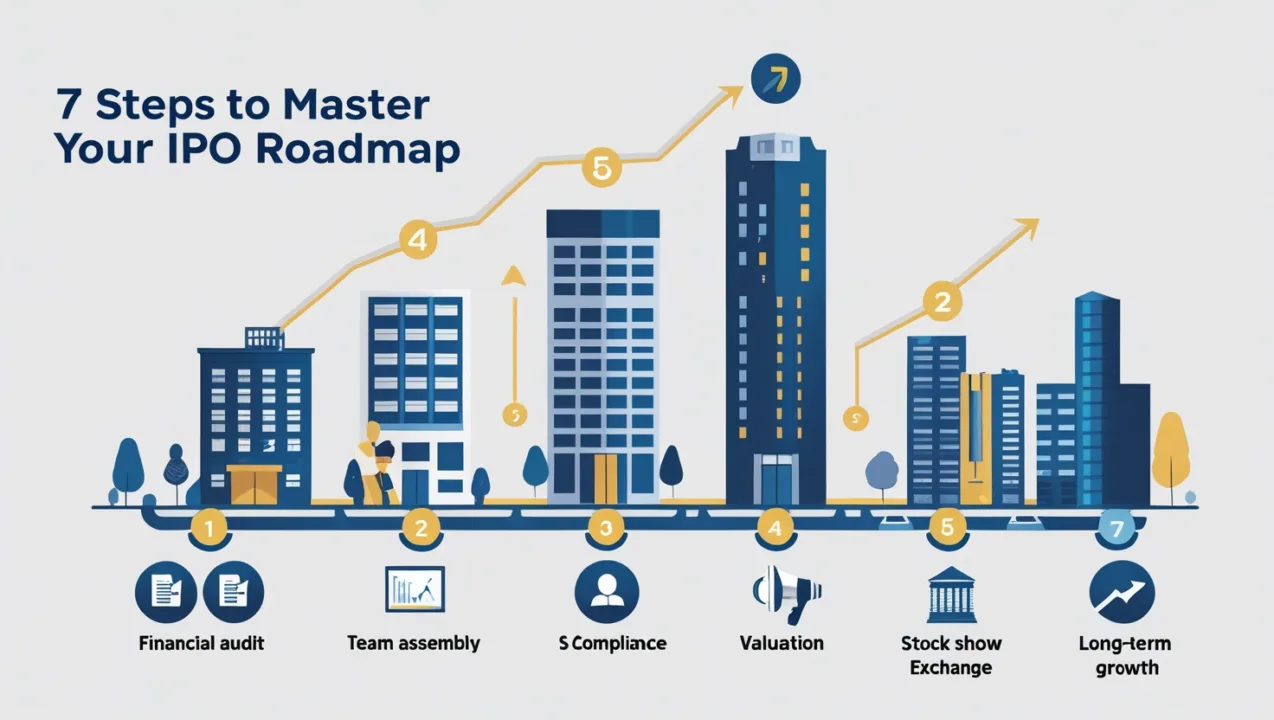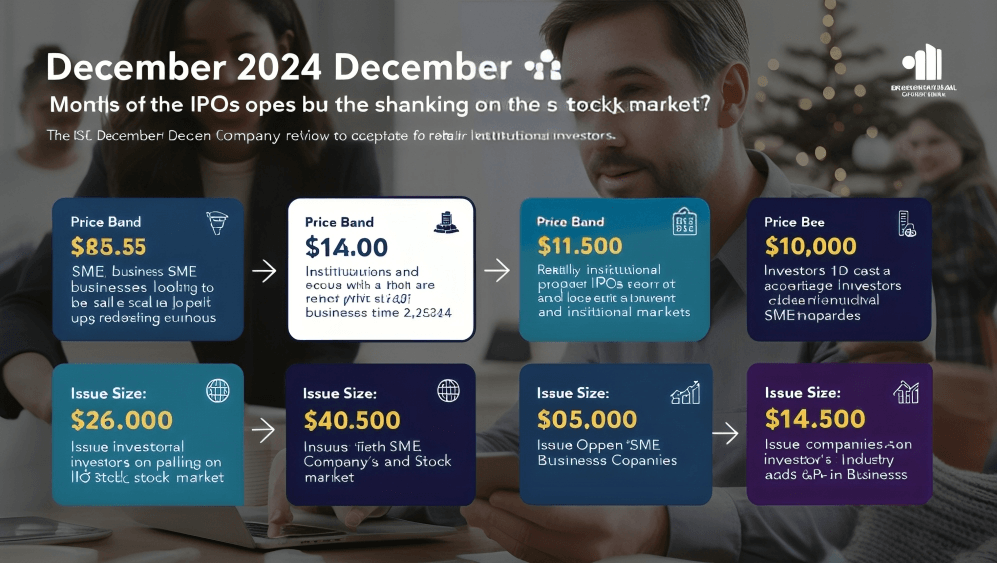IPO Roadmap: A Step-by-Step Guide to Taking Your Company Public in the USA

IPO Roadmap 7 Powerful Steps to Master Your IPO Successfully
Discover the complete IPO roadmap for the USA market. Learn step-by-step strategies, from pre-IPO preparation to post-IPO success, and overcome key challenges to go public confidently.
People also read:
If you’re interested in specific IPO opportunities, check out these articles:
- GrubMarket IPO 2025: Investment Opportunities
These articles provide insights into upcoming IPOs and why they might be worth considering.
What is an IPO Roadmap?
An IPO roadmap is a strategic plan that outlines the steps a company must take to go public. It serves as a blueprint for the entire IPO process, ensuring all stakeholders are aligned and that the company meets regulatory requirements.
Definition of an IPO Roadmap
An IPO roadmap is a detailed plan that covers all aspects of the IPO process, including financial preparation, regulatory compliance, valuation, and investor outreach. It helps companies stay on track and avoid costly mistakes.
Importance of a Well-Defined IPO Roadmap
A well-defined IPO roadmap is crucial for several reasons:
- It ensures regulatory compliance with bodies like the SEC.
- It minimizes financial and operational risks.
- It builds investor confidence by demonstrating a clear growth plan.
Why is an IPO Roadmap Important for Companies?
Going public is a transformative event that requires careful planning. An IPO roadmap provides clarity and direction, helping companies navigate the complexities of the process.
Ensuring Regulatory Compliance
The IPO process in the USA is governed by strict regulations set by the Securities and Exchange Commission (SEC). An IPO roadmap ensures that all regulatory requirements, such as filing Form S-1, are met on time.
Minimizing Risks and Costs
The IPO process can be expensive, with costs ranging from
2 million to 10 million. A well-structured IPO roadmap helps companies identify potential risks and allocate resources efficiently, reducing unnecessary expenses.
Attracting Investors
Investors are more likely to support a company with a clear and actionable IPO roadmap. It demonstrates that the company is well-prepared and has a solid plan for long-term growth.
Step-by-Step IPO Roadmap for the USA Market
The IPO process can be broken down into six key steps. Each step is critical to ensuring a successful transition to becoming a publicly traded company.
Step 1: Pre-IPO Preparation
Before embarking on the IPO journey, companies must ensure they are financially and operationally ready. This includes:
- Conducting a financial audit for the past 3-5 years.
- Strengthening corporate governance structures.
- Addressing any legal or regulatory issues.
Step 2: Assembling Your IPO Team
An IPO requires a team of experts, including:
- Investment bankers to underwrite the offering.
- Lawyers to handle legal and regulatory matters.
- Auditors to ensure financial statements are accurate.
Step 3: SEC Registration and Compliance
The next step is to file Form S-1 with the SEC. This document includes detailed information about the company’s financials, business model, and risks. The SEC reviews the filing and may request additional information.
Step 4: Valuation and Pricing
Valuation is a critical step in the IPO process. Companies work with investment bankers to determine their valuation and set the IPO price. Factors like market conditions, financial performance, and investor demand play a key role in this process.
Step 5: Roadshow and Investor Pitching
The Roadshow is where the company pitches its story to potential investors. This involves:
- Presenting the company’s growth potential.
- Highlighting competitive advantages.
- Addressing investor concerns.
Step 6: Going Public and Listing on the Stock Exchange
On the day of the IPO, the company’s shares are listed on a stock exchange (e.g., NYSE or Nasdaq). The stock begins trading, and the company becomes a publicly traded entity.
Related Reads:
“Looking for more insights into IPOs? Explore these articles:
- Top 10 Insights: IPO GMP for Maximum Profits
These resources will help you understand historical IPO performances and strategies for maximizing profits.”
Key Challenges in the IPO Process and How to Overcome Them
The IPO process is not without its challenges. Here are some common hurdles and how to address them:
Regulatory Hurdles
The SEC has strict requirements for companies going public. To overcome this, work closely with legal and financial experts to ensure all filings are accurate and complete.
Market Volatility
Market conditions can impact the success of an IPO. To mitigate this, choose the right timing for your IPO and be prepared to adjust your plans if necessary.
Investor Skepticism
Investors may be hesitant to support a new IPO. Build trust by being transparent about your financials and growth prospects.
Post-IPO Strategies for Long-Term Success
Going public is just the beginning. Companies must focus on long-term strategies to maintain their success.
Managing Investor Expectations
Communicate regularly with shareholders and provide updates on financial performance and growth initiatives.
Maintaining Financial Performance
Deliver on the promises made during the IPO. Focus on achieving financial targets and driving sustainable growth.
Navigating Public Scrutiny
As a public company, you’ll face increased scrutiny from the media and investors. Be prepared to handle this by maintaining strong corporate governance and transparency.
Final Thought
An IPO is a complex but rewarding process that can unlock significant growth opportunities for your company. By following this IPO roadmap, you can navigate the challenges and maximize your chances of success. If you’re considering going public, start preparing today and consult with experienced IPO advisors to ensure a smooth journey.
Further Reading:
“For more in-depth analysis of IPO opportunities and strategies, check out these articles:
- GrubMarket IPO 2025: Investment Opportunities
These articles provide valuable insights into upcoming IPOs and investment strategies.”
FAQ
How long does the IPO process take?
The IPO process typically takes 6-12 months, depending on the company’s readiness and market conditions.
What are the costs involved in an IPO?
The costs of an IPO can range from
2 million to 10 million, including underwriting, legal, and accounting fees.
What are the key risks of going public?
The key risks include market volatility, regulatory scrutiny, and loss of control for founders.
For further reading on IPO regulations and best practices, refer to:
- SEC Official Guidelines – U.S. Securities and Exchange Commission’s IPO resource hub Click Here
- Nasdaq IPO Process – Detailed insights into Nasdaq’s IPO requirements Click Here
- Investopedia: IPO Basics – Beginner-friendly explanation of IPOs Click Here
Disclaimer
The information provided in this article is for educational and informational purposes only and does not constitute legal, financial, or professional advice. While we strive to ensure the accuracy and reliability of the content, the IPO process is subject to regulatory changes, market conditions, and individual circumstances. Readers are advised to consult with qualified legal, financial, or IPO advisors before making any decisions related to going public. The author and publisher are not liable for any actions taken based on the information provided in this article. External links are provided for reference only, and we do not endorse or assume responsibility for the content of third-party websites.
Which IPO is best upcoming?
As of 2025, some of the most highly anticipated IPOs in the USA include companies like Klarna, which is reportedly preparing for an IPO in 2025, and SpaceX, which has been the subject of much speculation around a possible public offering. Additionally, the Databricks IPO is another one to watch closely. Each of these IPOs has massive potential in their respective industries (fintech, aerospace, and AI), making them top picks for investors looking for growth opportunities. Keep an eye on the latest announcements to identify which IPOs could be a fit for your investment strategy.
What is the roadmap of IPO in India?
The IPO process in India typically follows a multi-step journey, but for USA-based investors, understanding the timeline is essential:
Drafting of Prospectus: Companies looking to go public file an initial draft with SEBI (Securities and Exchange Board of India).
SEBI Review: After submission, SEBI reviews the documents and may ask for clarifications.
Pricing of IPO: Once cleared, the company sets the price range for the shares.
Public Offering: The IPO is launched and shares are offered to the public.
Listing on Exchanges: Upon successful subscription, the company is listed on major Indian stock exchanges like BSE or NSE.
This roadmap is similar to the IPO process in the USA but adheres to India’s specific regulatory requirements, including the SEBI oversight.
What are the 7 steps to getting an IPO?
The IPO process can generally be broken down into seven key steps:
Pre-IPO Planning: Assess the company’s readiness for public markets.
Hiring Underwriters: Select investment banks to handle the IPO.
Due Diligence & Filings: Prepare and file the registration documents with the SEC (Securities and Exchange Commission) or SEBI (in India).
Setting the IPO Price: Determine the offering price after discussions with underwriters.
Marketing the IPO: Underwriters market the IPO to institutional investors (roadshows).
Launching the IPO: Shares are made available to the public through a subscription process.
Post-IPO: The stock begins trading on the exchange and the company starts life as a public entity.
For USA investors, the SEC is a central body overseeing the process, ensuring transparency and fairness.
What is the 3-day rule for IPO?
The “3-day rule” refers to the standard period following an IPO where early investors (like institutional investors) typically hold their shares for a short time before selling them on the market. After this initial “lock-up” period, the shares are often allowed to trade freely, which can lead to significant volatility. However, this rule is specific to IPOs in the USA and does not apply universally. Investors often watch for this window to gauge the potential for price movement post-IPO.
Let me know if you need more details on any of these topics!









